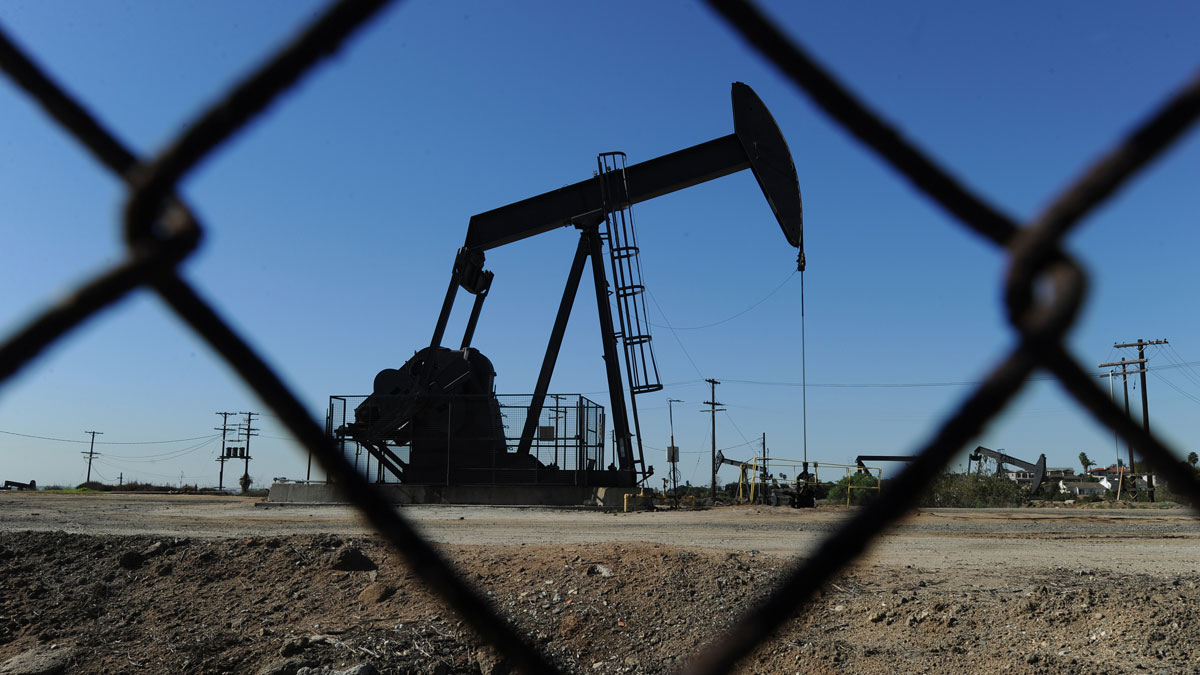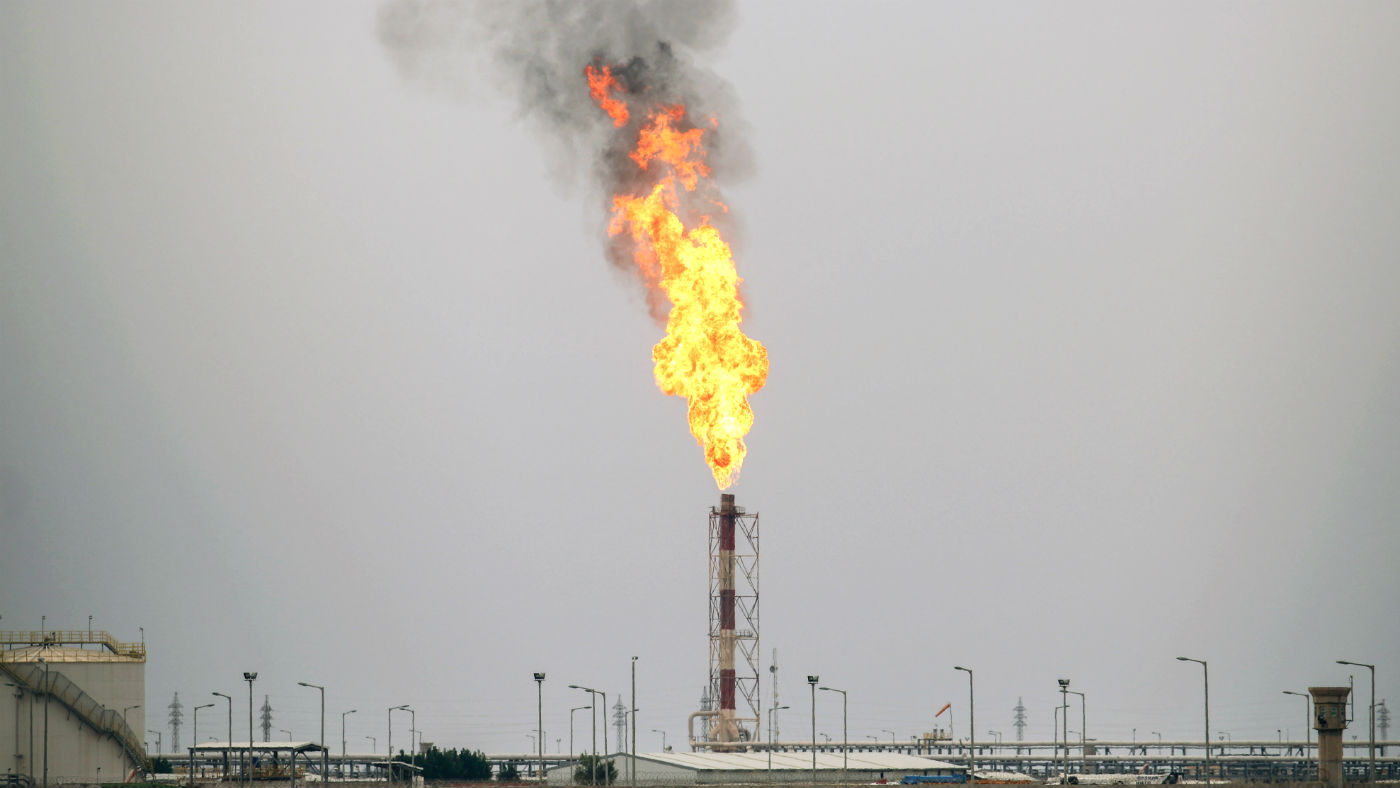Oil price posts two-year highs - but how long can it last?
Brent rose above $59 a barrel this week, its best third-quarter showing since 2004

Oil price slumps again - how low will it go?
15 June
The oil price plunged to near its lowest level for seven months yesterday as concern continued to mount over whether production cuts would be sufficient to balance global supply and demand.
Both Brent crude and West Texas Intermediate (WTI) slumped by around four per cent to session lows of $46.70 and $44.30 respectively.
The Week
Escape your echo chamber. Get the facts behind the news, plus analysis from multiple perspectives.

Sign up for The Week's Free Newsletters
From our morning news briefing to a weekly Good News Newsletter, get the best of The Week delivered directly to your inbox.
From our morning news briefing to a weekly Good News Newsletter, get the best of The Week delivered directly to your inbox.
That put them at seven-week lows and hovering close to levels last November, when producers including Opec and Russia agreed to cut output by 1.8 million barrels a day.
Fereidun Fesharaki, founder and chairman of oil and gas consulting group FGE, told CNBC that without more stringent cuts, the oil price could fall back to its levels of early last year, when it was between $30 and $35 a barrel.
Triggering yesterday's fall was data from the US Energy Information Administration (EIA) saying overall crude supplies fell by 1.5 million barrels while petrol stocks jumped by 2.1 million barrels, suggesting excess refinery ate into raw crude stocks and that demand is insufficient to clear stocks.
At the same time, the EIA believes US production, boosted by a renascent shale sector, will rise by 460,000 barrels per day this year. Last December, it predicted a fall of 80,000 barrels per day, says Reuters.
A free daily email with the biggest news stories of the day – and the best features from TheWeek.com
Opec itself thinks US oil output will surge by 800,000 barrels, while separate figures yesterday revealed Opec exports have only fallen 300,000 barrels, despite the headline cuts.
The final straw is an estimate from the International Energy Agency that additional supply will outstrip increased demand next year, with a forecast of 1.5 million barrels per day compared to 1.4 million.
Opec last month agreed to extend its cuts to March next year - but prices have fallen 13 per cent since then as traders had hoped for deeper reductions.
Fesharaki said: "You have to cut another 700,000 barrels per day right away or prices will sink.
"Even if you do this, next year you'll still have to cut more, so it comes down to how far the Saudis are prepared to cut."
Oil price slumps as US shale predicted to surge
8 June
The oil price slumped yesterday after the US regulator's latest data release pointed t05o surging US production and painted a bearish picture on current stockpiles.
Brent crude, the international oil price benchmark, fell more than 3.5 per cent to around $48.35 a barrel - its lowest level in five weeks. After falling further in Asian trading overnight, it edged back to a similar level again this morning.
Its US counterpart West Texas Intermediate suffered a similarly sharp drop and hit its lowest level in more than a month. It recovered from its own overnight dip to hit $46 a barrel this morning.
Triggering the latest nosedive was the latest weekly data report from the Energy Information Administration (EIA), with the market particularly spooked, says the Daily Telegraph, by its prediction that US shale oil output could hit a record of ten million barrels a day next year.
That's as much as the largest producers in the world, Saudi Arabia and Russia, and an extra 700,000 barrels on current levels.
Opec and Russia, among other oil producers, have pledged a daily cut in production of 1.8 million barrels until next March. Traders, however, doubt this will be enough to rebalance the market and the recovery in US production is a key concern.
MarketWatch says the EIA data shocked the market "in more ways than one".
After a few weeks of decline, US crude stockpiles jumped by 3.3 million barrels, while both petrol and diesel stocks grew, by 3.3 and 4.4 million barrels respectively.
"The report from the EIA [also] showed a 'stunning' 1.4 million barrel-per-day drop in demand last week across all petroleum products," said Tom Kloza, global head of energy analysis at the Oil Price Information Service.
In combination, the statistics suggest near-record and rising stocks, falling demand and rising production. None of which is good news for traders concerned about persistent oil oversupply.
Oil price swings amid Middle East schism
5 June
The oil price is sliding again this afternoon after sentiment turned negative again amid a diplomatic row in the Middle East.
At the time of writing, Brent crude was down 1.1 per cent to $49.40 a barrel while its US counterpart West Texas Intermediate had fallen 0.9 per cent at $47.22.
This morning, the international oil price benchmark hit above $50 a barrel when several Arab states, including Saudi Arabia, Bahrain, the United Arab Emirates (UAE) and Egypt, cut ties with Opec member Qatar, raising concerns over oil shipments.
"The Saudi-led Arab coalition fighting Yemen's Houthi rebels also expelled Qatar from its alliance," says the BBC.
As oversupply is the market's key concern, the diplomatic row was at first seen as positive by traders, but attention quickly turned to the problems the row raises with Opec.
Saudi Arabia and the UAE are also members of the cartel, as is Qatar's ally Iran.
Opec is currently leading an agreement to cut 1.8 million barrels per day from supplies until next March. Acrimony within the group could undermine these efforts to rebalance the market.
Phin Ziebell, of National Australia Bank, told Market Watch: "Qatar may have little reason to keep the production quota and if that happens, it might encourage other Opec members to cheat too."
In addition, if the row rolls on, it may prove difficult to keep oil shipments moving along the strategically important Strait of Hormuz waterway.
Oil price back above $50 as Arab states cut off Qatar
05 June AM
Brent crude is back above $50 a barrel this morning after a diplomatic row in the Middle East raised concerns over oil shipments.
The international oil price benchmark rose 0.5 per cent to hit $50.18 a barrel, while its US counterpart West Texas Intermediate was up 0.6 per cent to $47.92 following the news that several countries have severed ties with Qatar.
Saudi Arabia has closed its land borders with the peninsula and cut all air and sea contact, a move also seen from Bahrain and the United Arab Emirates. All three have banned Qatar Airways flights from their airspace.
"The Saudi-led Arab coalition fighting Yemen's Houthi rebels also expelled Qatar from its alliance," says the BBC.
Together with Egypt, the countries accuse Qatar of supporting "terrorism and extremism" and allege that the government or wealthy individuals in the emirate have provided funding and resources to Islamic State and the Nusra Front, an al-Qaeda affiliate. Qatar denies the claims.
The BBC says the row is actually a culmination of a complex regional schism that puts Doha on the side of Saudi Arabia's rival Iran, which ironically represents a branch of Islam that is opposed to both IS and Nusra.
Qatar, a member of the Opec oil cartel, relies on the Strait of Hormuz waterway, says the Daily Telegraph, and as that passes through both Iranian and UAE waters, regional shipments could be disrupted, which would have consequences for global oil supply.
The oil price has long been in the thrall of supply trends: Brent crude fell below $50 a barrel last week over doubts that supply cuts by Opec, Russia and others would be enough to rebalance the market.
Oil price drops below $50 as 'game of chicken' starts again
02 June
After slipping below $50 earlier this week, the international oil price fell again this morning as traders worried about global oversupply.
Brent crude, the international oil price benchmark that sets prices in the North Sea, dropped back below $50 a barrel on Wednesday. This morning, after a brief recovery yesterday, it was down almost three per cent at close to $49.
Its US counterpart West Texas Intermediate was down three per cent this morning and below $47 a barrel.
Both benchmarks dipped last week after Opec, Russia and others renewed their 1.8 million-barrels-per-day output cuts for a further nine months to March 2018.
In some respects this was counter-intuitive, but it reflects the disappointment in producers failing to go further in terms of the scale of the cuts.
"The game of chicken between them [Opec] and the market is back on again," says John Kilduff, a partner at Again Capital.
At issue is the ongoing problem of oversupply – the market is still sitting on a huge stockpile of crude oil from the excess production of the past two years. Even as US reserves begin to fall, production is rising again in key areas.
"The decline in oil prices [on Wednesday] was triggered by news that Libya had increased its production to a three-year high of 827,000 barrels a day," says CNBC.
"Behind the subsequent decline [this morning] was a return to focus on rising production after US average daily output last week hit its highest level since August 2015," adds MarketWatch.
There is also a general sense that output cuts were ineffective because oil exports were virtually unchanged and global inventories remain well stocked.
-
 A lemon-shaped exoplanet is squeezing what we know about planet formation
A lemon-shaped exoplanet is squeezing what we know about planet formationUnder the radar It may be made from a former star
-
 Political cartoons for January 4
Political cartoons for January 4Cartoons Sunday's political cartoons include a resolution to learn a new language, and new names in Hades and on battleships
-
 The ultimate films of 2025 by genre
The ultimate films of 2025 by genreThe Week Recommends From comedies to thrillers, documentaries to animations, 2025 featured some unforgettable film moments
-
 How might the Israel-Hamas war affect the global economy?
How might the Israel-Hamas war affect the global economy?Today's Big Question Regional escalation could send oil prices and inflation sky-high, sparking a worldwide recession
-
 Recent mega-mergers could signal a turning point for the US oil industry
Recent mega-mergers could signal a turning point for the US oil industryTalking Point Both Chevron and Exxon have recently spent billions to acquire smaller oil companies
-
 Has Saudi Arabia lost control of oil prices?
Has Saudi Arabia lost control of oil prices?Today's Big Question Kingdom goes it alone to cut production, risking tension with US and reigniting cooling inflation in Europe
-
 US angered by Opec+ oil cut
US angered by Opec+ oil cutSpeed Read Energy prices to rise further as producers slash supply by two million barrels a day
-
 Global oil demand forecast lowered for 2020 and 2021
Global oil demand forecast lowered for 2020 and 2021Speed Read IEA report says jet fuel demand remains the major source of weakness
-
 Are US-Iran tensions flaring again?
Are US-Iran tensions flaring again?In Depth Trump threatens military action over Twitter
-
 Can a deal be struck to raise oil prices?
Can a deal be struck to raise oil prices?In Depth Opec+ will convene today over video link in a bid to boost crude
-
 What do negative oil prices mean?
What do negative oil prices mean?In Depth Perfect storm of oversupply and storage shortages sees producers paying to get rid of US crude